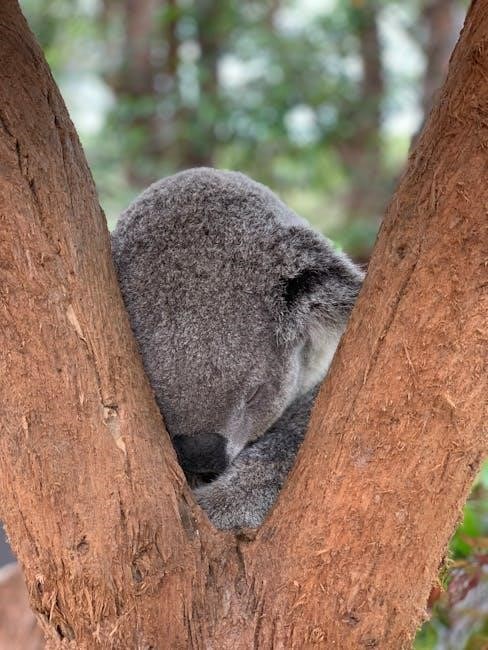
Australia’s unique climate and diverse flora create an environment where tree diseases thrive, impacting ecosystem health and property values. This guide helps identify and manage these issues effectively.
Why Tree Health Matters in Australia
Trees are integral to Australia’s environment, providing shade, enhancing beauty, and supporting biodiversity. Diseased trees can lead to structural weaknesses, safety hazards, and ecological imbalances. Early detection and management of tree diseases are critical to preserving the health of individual trees and entire ecosystems. Healthy trees contribute to air quality, soil stability, and wildlife habitats, making their maintenance essential for both urban and natural landscapes across Australia.
Overview of Common Tree Diseases in Australia
Australia faces a variety of tree diseases, with fungal infections being the most prevalent. Cypress Canker and Myrtle Rust are particularly destructive, causing rapid decline in affected species. Pink Disease and Root Rot target multiple tree types, while Oak Wilt spreads quickly through soil and insects. These diseases weaken tree structures, leading to decay and death. Understanding their causes and symptoms is crucial for effective prevention and management strategies to protect Australia’s diverse tree population.

Common Signs of Tree Diseases
Early signs of tree diseases include yellowing leaves, cracked bark, and fungal growths, often indicating stress or infection. Recognizing these signs is crucial for timely intervention.
Visible Changes in Foliage and Discolouration
One of the earliest signs of tree disease is discolouration or unusual changes in foliage. Leaves may turn yellow, brown, or exhibit blotchy patterns, often indicating stress or infection. In some cases, leaves may curl, wilt, or drop prematurely. These changes can signal fungal, bacterial, or viral infections, making early detection crucial for effective treatment. Monitoring leaf health helps identify issues before they escalate, ensuring timely intervention to preserve tree vitality and prevent further damage.
Cracked or Unusual Bark
Cracked or unusual bark is a key indicator of tree stress or disease. It may appear as deep fissures, peeling layers, or abnormal growths, often signaling underlying issues like fungal infections or pest infestations. Regularly inspecting tree bark can help detect problems early, as unhealthy bark can lead to decay or structural weakness. In some cases, such as canker diseases, cracks may exude sap or display discoloured streaks, requiring prompt intervention to prevent further damage or tree death. Early action is crucial for preserving tree health.
Fungal Growth and Unusual Structures
Fungal growth and unusual structures on trees are often clear signs of disease. Mushrooms, brackets, or other peculiar formations can indicate infections like root rot or canker diseases. These growths may appear colorful or misshapen, damaging the tree by infecting its vascular system. Early detection of such structures is critical, as they can lead to decay or structural weakness. Professional inspection is recommended to identify the underlying cause and prevent further harm to the tree.

Top Tree Diseases in Australia
Australia faces several destructive tree diseases, including Cypress Canker, Myrtle Rust, Pink Disease, Root Rot, and Oak Wilt. These diseases cause widespread defoliation and tree death, threatening native and urban forests.
Cypress Canker
Cypress Canker is a water-borne fungal infection causing deep red cankers on branches, leading to rapid death. It spreads through spores, infecting healthy trees and causing widespread damage. Early detection is crucial, as affected branches can die within 24 hours. Management involves pruning infected areas and improving air circulation. If left untreated, the disease can devastate entire trees and spread to nearby plants, making prompt action essential for preserving tree health and preventing further infestation.
Myrtle Rust
Myrtle Rust is a destructive fungal disease affecting plants in the Myrtaceae family. It was first detected in Australia in 2010 and spreads rapidly via airborne spores. Symptoms include bright yellow powdery spots on leaves, which turn brown or grey before dying. Swift action is essential, requiring fungicide treatment and isolation to prevent further spread. If untreated, it can severely damage native species and ecosystems, making early detection critical for effective management and conservation efforts.
Pink Disease
Pink Disease is a fungal infection that affects various tree species in Australia, particularly impacting citrus farmers in NSW, Queensland, and the Northern Territory. It causes the bark to swell, split, and kill the tree quickly. To manage this disease, it’s crucial to remove and burn affected branches immediately, preventing the spread of spores and protecting nearby trees. Early intervention is vital to mitigate its devastating effects on orchards and native ecosystems.
Root Rot
Root rot is a destructive disease caused by fungi, leading to the rapid decay of a tree’s root system while still alive. Signs include small, discolored, and wilted leaves, with branches showing decay. It’s challenging to diagnose and often requires the expertise of an arborist. To prevent root rot, ensure well-drained soil and proper cultivation around the tree. Early detection is crucial for effective management and preserving the tree’s health and stability, especially in Australia’s diverse climates and soil conditions.
Oak Wilt
Oak Wilt is a soil-borne fungal disease spread by beetles, causing wilted, rust-colored leaves that remain on the tree out of season. It can kill a tree within a single growing season if left untreated. Management involves trenching around the roots to isolate the infection and prevent further spread. Early intervention is critical to protect neighboring trees from this highly contagious and destructive disease, especially in Australia’s vulnerable ecosystems.
Causes and Risk Factors
Tree diseases in Australia are often caused by fungal, bacterial, or viral pathogens, exacerbated by environmental stressors like drought, poor soil conditions, and improper tree maintenance practices.
Fungal Infections
Fungal infections are a prevalent cause of tree diseases in Australia, often leading to conditions like Cypress Canker and Myrtle Rust. These pathogens thrive in moist environments, spreading through spores that infect healthy tissue. Fungal diseases can cause discoloration, structural damage, and premature death. Trees under environmental stress or with improper maintenance are more susceptible. Early detection is critical, as fungal infections can rapidly spread, affecting entire trees and nearby plants. Professional intervention is often necessary to manage severe outbreaks effectively.
Bacterial and Viral Pathogens
Bacterial and viral pathogens pose significant threats to tree health in Australia, causing diseases like Olive Knot and Citrus Canker. These pathogens often enter through wounds or insect vectors, leading to symptoms such as cankers, galls, and tissue decay. Bacterial infections can spread rapidly, especially in moist conditions, while viral diseases may cause mottling or stunted growth. Controlling these pathogens requires strict sanitation, pruning, and sometimes chemical treatments to prevent further damage and protect surrounding trees from infection.
Environmental Stressors
Environmental stressors, such as extreme weather, soil conditions, and improper planting practices, weaken trees, making them vulnerable to disease. Factors like poor drainage, nutrient deficiencies, and temperature fluctuations can impair tree health. Incorrect mulching and pruning techniques also stress trees, increasing susceptibility to pathogens. Addressing these stressors through proper tree care and soil management is crucial for preventing disease and maintaining tree vitality in Australia’s diverse climate zones.
Prevention and Management Strategies
Regular inspections, proper pruning, and using resistant tree species are key to preventing disease. Biological controls and soil management also help mitigate tree disease risks effectively.
Early Detection and Monitoring
Early detection of tree diseases is crucial for effective management. Regular inspections of foliage, bark, and roots can identify symptoms like discolouration, cracking, or unusual growths. Monitoring seasonal changes in leaf health and vigour helps spot issues before they escalate. Using a comprehensive guide or consulting professionals ensures timely intervention, preventing disease spread and promoting tree recovery. Swift action enhances survival rates and maintains ecosystem balance.
Proper Tree Maintenance
Proper tree maintenance is key to preventing diseases and ensuring tree health. Regular pruning removes diseased or damaged branches, reducing the risk of infection spread. Mulching and watering practices should avoid over-saturation, which can lead to root rot. Seasonal inspections by arborists help identify early signs of stress or disease. Correct planting techniques, including suitable soil selection, also minimize susceptibility to pathogens. Consistent care fosters resilience, protecting trees from environmental and biological threats.
Chemical and Organic Solutions
Chemical solutions, such as fungicides, can effectively treat tree diseases when applied correctly. Organic alternatives, including neem oil and copper-based products, offer eco-friendly options to combat pathogens. Both methods should be used judiciously, following expert guidelines to avoid harming the tree or the environment. Regular applications during pruning or seasonal changes can prevent disease spread, ensuring long-term tree health and sustainability. Always consult professionals for tailored treatment plans.
Regional Variations in Tree Diseases
Regional variations in tree diseases across Australia are influenced by climate and species diversity. Different pathogens thrive in specific zones, necessitating tailored management strategies for effective conservation.
Diseases Specific to Eastern Australia
Eastern Australia faces unique tree disease challenges due to its subtropical climate. Myrtle Rust, a highly invasive fungus, severely impacts native species like eucalyptus and paperbark. Pink Disease is prevalent, causing bark swelling and death in citrus and native trees. Root Rot thrives in wet conditions, decaying root systems of flood-prone trees. Regular monitoring and early intervention are crucial to mitigate these threats, especially in regions like northern New South Wales and southeastern Queensland.
Diseases Common in Western Australia
Western Australia faces distinct tree disease challenges, with Quambalaria leaf spot affecting eucalyptus and Corymbia species. Armillaria root rot is prevalent, causing widespread root decay. Environmental stressors like drought exacerbate these issues, particularly in native species. Early detection and targeted management are essential to combat these diseases, ensuring the preservation of Western Australia’s unique flora and ecosystem health.

Case Studies and Real-World Examples
Real-world examples highlight successful disease management strategies, such as early detection of Myrtle Rust and Cypress Canker, showcasing the importance of proactive measures and learned lessons.
Successful Disease Management Scenarios
A notable example of effective disease management involves a citrus grove in Queensland battling Pink Disease. Early detection of symptoms like swollen bark and discoloration led to prompt pruning of infected branches and fungicide treatment. Regular monitoring and soil improvement measures ensured the grove’s recovery, highlighting the importance of swift action and integrated strategies in preserving tree health and productivity.
Lessons Learned from Severe Outbreaks
Severe outbreaks, such as the Myrtle Rust epidemic, have taught valuable lessons about the importance of early detection and rapid response. The fungus, first detected in 2010, spread swiftly across eastern Australia, affecting native species. This outbreak underscored the need for public awareness, strict quarantine measures, and collaborative efforts between governments and landowners to mitigate the impact of invasive pathogens and protect vulnerable ecosystems.

When to Call a Professional
Recognizing when professional expertise is necessary is crucial for effectively managing tree diseases. Severe infections, unclear symptoms, or widespread damage often require arborists’ specialized knowledge and tools.
The Role of Arborists in Disease Identification
Arborists play a vital role in identifying tree diseases, utilizing specialized knowledge to diagnose issues accurately. They inspect foliage, bark, and overall tree health, detecting early signs of infection. With expertise in fungal, bacterial, and viral pathogens, arborists recommend targeted treatments, pruning, or removal to prevent disease spread. Their interventions ensure tree longevity and landscape preservation, making them indispensable in maintaining urban and rural tree health effectively.
Emergency Tree Services for Diseased Trees
Emergency tree services are crucial for addressing severely diseased trees that pose immediate risks. Professional arborists provide 24/7 responses, including urgent pruning or removal to prevent disease spread and property damage. These services ensure safety while preserving surrounding landscape integrity. Prompt action is essential to protect healthy trees and avoid further ecological impact, making emergency tree care a vital component of disease management strategies in Australia.